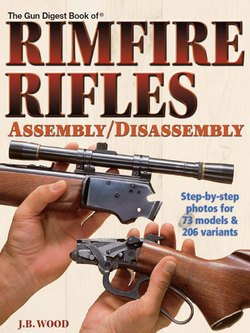Читать книгу The Gun Digest Book of Rimfire Rifles Assembly/Disassembly - J.B. Wood - Страница 6
На сайте Литреса книга снята с продажи.
ОглавлениеIntroduction
Every gunsmith is familiar with what might be called the “sack-of-parts” syndrome. Customers frequently arrive with guns totally or partially disassembled, in all manner of containers. I have seen them in cigar boxes, paper sacks, plastic bags, glass jars, and once in an aluminum vase, the type used to put flowers on graves. In most cases, the reason for the complete takedown was “cleaning,” and the unfortunate owner then couldn’t remember the proper position of all those small parts and springs.
If the owner had the manual or instruction sheet supplied with each new gun, it was often of little help, as most of these go only as far as simple field-stripping,. For some of the older guns, the manuals are scarce collector items, and are not readily obtainable. With some imported guns, the direct-translation sheets are amusing to read, but nearly useless as a guide. Good, clear instructions on total takedown and reassembly were obviously needed, and this is the idea behind this series of books. Volumes I and II cover pistols and revolvers, and the next two books in the series cover centerfire rifles and shotguns.
In complete disassembly and reassembly, there are some points that may require the special tools and skills of the gunsmith. A very knowledgeable amateur can usually manage it, but he must have some mechanical aptitude. This book is intended for both the average gun person and the professional, and for this reason even the simpler operations are described and shown in detail.
Some of the tools required are of a type not readily available at the local hardware store, so I am including a section on tools, and giving the sources from which they may be obtained.
In the takedown of any gun, there are a few general rules which apply. A light tap with a plastic mallet may sometimes be necessary to free a tight assembly, but no extreme force should be used. Always wear safety glasses to protect the eyes from parts expelled by compressed springs. Do not disassemble a gun outdoors, over tall grass, or indoors, over a shag rug. Before you start, read the instructions through, all the way, at least once.
I assume that my readers are sufficiently intelligent not to work on a loaded gun, so I will not begin each set of instructions by repeating that the gun must be entirely unloaded. I’ll say it once, right here: Before you begin the disassembly of any gun, be sure that all cartridges are removed. Don’t trust the feed and ejection systems— make a thorough visual inspection. Some tube-magazine types can “hide” a round in the mechanism.
An important addition to the back of this book is a comprehensive index and cross-reference list, linking all of the rifles covered here to guns of similar or identical pattern. When these are included in the count, the instructions in this revised edition can be used for the takedown and reassembly of hundreds of rifles.
The Gun Digest® Book of Exploded Gun Drawings, also available from Krause Publications, is an excellent companion to this book, showing parts relationships and factory part numbers for 975 guns.
J.B. Wood
Raintree House
Corydon, Kentucky
December, 2005
A Note on Reassembly
Most of the rifles covered in this book can be reassembled by simply reversing the order of disassembly, carefully replacing the parts in the same manner they were removed. In a few instances, special instruction are required, and these are listed with each gun under “Reassembly Tips.” In certain cases, reassembly photos are also provided.
If there are no special instructions or photos with a particular gun, you may assume that it can just be reassembled in reverse order. During disassembly, note the relationship of all parts and springs, and lay them out on the workbench in the order they were removed. By following this procedure you should have no difficulty.
